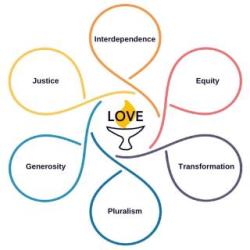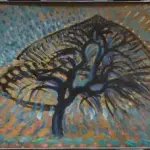 (Today’s article is by guest writer, Alexander Cheruk. For a brief bio, see below.)
(Today’s article is by guest writer, Alexander Cheruk. For a brief bio, see below.)
In Religion is Not About God, American philosopher Loyal Rue presents a series of plausible doomsday scenarios that merit our attention. Citing ecological discontinuities, unpredictable chemical synergisms, runaway greenhouse disaster, infectious diseases, worldwide crop failures, and bioterrorism, Rue highlights a sobering reality: the possibilities for global catastrophe are endless. This is not idle speculation: it’s a warning. As we push beyond the limits of sustainability and weave dense economic interdependencies globally, human life becomes increasingly fragile, vulnerable, and dystopian. It’s as if we’re all passengers aboard a ship, naively assuming it’s unsinkability, yet overloading it ever more precariously.
Should a global disaster occur, Rue argues that the dominant narratives in the grim aftermath will revolve around the theme of overshoot and collapse, attributing civilization’s demise to the unsustainable demands we’ve placed on our planet’s finite resources. He predicts that these explanations will eventually expand to a modern, nature-centered mythology explaining that the apocalypse happened because we did not accept our status as natural beings, assumed the constraints of nature did not apply to human fate, and devalued the order of nature. Rue further anticipates that from the ruins of this event, a nature-centered meta-myth will emerge, one that he identifies as the core myth of Religious Naturalism (RN). To Rue, Religious Naturalism rests on the “evolutionary cosmology of contemporary science, a story about the natural history of the cosmos, the creation and emergence of the universe from the big bang to the environmental crisis and beyond.”
Rue further contends that a post-disaster RN vision should combine this cosmology with an eco-centric moral framework. This framework would be indispensable for preserving human life on Earth by linking our needs for personal wholeness and social coherence to the conditions of natural systems. He notes that RN already exists as a religious orientation, but that it has not yet solidified into a robust tradition due to the absence of what he calls ancillary strategies. These are strategies that influence behavior-mediation systems and are essential for the flourishing of a religious tradition. According to Rue, religious phenomena can be broken down into five types of ancillary strategies:
- Intellectual: This strategy involves traditions of interpretation, generally maintained by philosophy or theology. Currently in the Religious Naturalist tradition, we see this approach taking shape among contemporary thinkers such as Jerome Stone, Donald Crosby, Loyal Rue, Michael Hogue, Carol Wayne White, Owen Flanagan, Karl Peters, Robert Corrington, Wesley Wildman, and Eric Steinhart, among others.
- Experiential: This includes mystical, numinous, and visionary experiences, serving as personal validations of a myth. Spiritual practices, drugs, natural beauty, art, and significant life events can facilitate these experiences, which can be interpreted naturalistically.
- Ritual: Rue defines ritual as “any repeatable unit of behavior, the performance of which engages individuals or groups in the meanings of a religious myth or is conducive to a religious experience.” Rituals under this context include prayers, pilgrimages, fasting, feasting, hymns, singing, chanting, kneeling, magic, worshiping, wedding or funeral ceremonies, and sacred dances, among others. Current RN thinkers and traditions are developing ritual strategies for naturalists.
- Aesthetic: This includes perceived objects that capture ultimate meanings through their natural forms, allowing for spiritual connection through aesthetic appreciation. Aesthetic expressions of Religious Naturalism include works that examine the beauty and spiritual significance derived from appreciating the natural world.
- Institutional: Traditionally, these have included ritual and ceremonial events, formalized instruction in schools, churches, monasteries, gurus, and missionary traditions. Institutional traditions of Religious Naturalism have been emerging since the late 90s, including the World Pantheist Movement (WPM), the Atheopagan Society, our very own Spiritual Naturalist Society (SNS), and the Religious Naturalist Association (RNA). The Secular Buddhist Association (SBA) could potentially be considered as an RN tradition, though it places less of an emphasis on the core myth of contemporary science (it has promoted ecodharma, however). These organizations are democratic, lacking authority figures and hierarchical power structures. They exist mostly online, though a few in-person groups have appeared.
Rue adds that RN may develop over the coming decades, but that it’s unlikely to become a dominant influence until a global disaster renders alternative myths inappropriate and distasteful. Yet, this view is challenged by Ursula Goodenough, Michael Cavanaugh, and Todd Macalister in The Routledge Handbook of Religious Naturalism, where they further elaborate on Rue’s thoughts:
While it may prove to be the case that the global adoption of an RN orientation will not happen without the kick-start of global catastrophe, the optimists in our midst envision an alternate sequence, wherein global adoption of this staves off global catastrophe. In this scenario, RN evangelism becomes a moral responsibility, even if we are only now struggling to figure out how to best deploy it.
The authors also add that in religious contexts, “evangelism” is frequently used instead of “publicity.” Though evangelism usually denotes the spreading of the Christian gospel, they note that it can also be defined as “zealous advocacy of a cause.”
One of the authors, Professor of Biology Ursula Goodenough, also mentions RN evangelism in her latest edition of The Sacred Depths of Nature, where she calls us to become evangelists and to pass on ecomoral principles to our communities by word and by example. She cites climate change, ethnic cleansing, fossil fuels, habitat and species preservation, human rights, hunger, inland waterways, infectious diseases, nuclear weapons, oceans, pollution, and population pressures as reasons why we need a planetary ethic, arguing that “without a common religious orientation, we basically don’t know where to begin, nor do we know what to say or how to listen, nor are we motivated to respond.”
A real-life example of RN Evangelism can be found in the inspiring work of the late Reverend Michael Dowd, and his surviving wife, writer and educator Connie Barlow. Since April 2002 until the time of Dowd’s death, Dowd and Barlow have traveled across North America as full-time “evolutionary evangelists.” Dowd saw his evangelism as a service to the future that aligned human self interest with the well-being of our planet.
Analogous to RN Evangelism, philosopher and theologian Jerome Stone has advocated for a “public ecotheology,” featuring “naturalistic public theologians” who either avoid traditional religious symbols with their supernaturalistic baggage or revise them in a naturalistic manner. He adds that naturalistic public theologians should only use naturalistic images of transcendence, and cites the Earth Charter as a resource for reflection on public theology from a Religious Naturalist position.
Despite his advocacy, Stone clarifies that Religious Naturalism will not solve environmental policy issues, some dilemmas in conservation biology, or complex interactions between humans and other life forms. He maintains however, that perceiving nature as sacred will profoundly influence our mindset, leading to more cautious actions and practical effects on our behavior. Stone also critiques Religious Naturalism as having not grown out of the struggle for caste, gender, or class justice, but recognizes its potential in challenging oppressive elements within traditional theism and the authoritative tendencies of some conservative religious, political, and social movements.
“Religious” vs. “Spiritual” Naturalism
A common objection to Goodenough, Cavanaugh, and Macalister’s promotion of the RN orientation is the “I would never use the R-word” response.” One of the most well-known critiques of this terminology can be found in The God Delusion by Richard Dawkins, where he argues that to call oneself religious is misleading because for most people, the word ‘religion’ implies ‘supernatural.’ On his website, Dawkins adds that his atheistic views are identical to Ursula’s religious views, stating “one of us is misusing the English language, and I don’t think it’s me.”
Professor of Religion, Bron Taylor has critiqued Dawkins’ stance in his 2009 book Dark Green Religion. Taylor has pointed out that Dawkins does not sufficiently address why nontheists often use religious terminology to articulate their deep-seated emotions and convictions about the world and their care for it. He emphasizes that humans are inherently social creatures, and that religious communities play a significant role in forming and reinforcing social norms.
Yet, Dawkins affirms that science can be spiritual in A Devil’s Chaplain. Professor of Philosophy Eric Steinhart notes this in Believing in Dawkins, where he proposes the term Spiritual Naturalism (SN) to refer to a science-based alternative to religion. Evidently, SNS adopts this term, and is the only known organization to incorporate it into its name. Our founder, Daniel Strain has contributed to The Routledge Handbook of Religious Naturalism, where he makes a distinction between Religious and Spiritual Naturalism:
Religious Naturalists mean religion in its best sense. That is, a tradition, body of knowledge, community, and practices—those things that promote our current understanding of the world and our place in it, as well as our values, wisdom, meaning, and inspiration. Spirituality is another matter. Though spiritual community and communal practices are a healthy part, spirituality is mainly about our inner experience and development and practices. Religion cannot manifest in its finest form unless its people have spirituality. Without that, religion becomes an institutional, bureaucratic, or even dogmatic endeavor—even when it is a naturalistic religion. Thus, it is possible for one to be spiritual without being religious. But, if we mean religion in its proper sense, it is impossible to be truly religious without being spiritual.
Despite some pushback against the use of the word “religious,” Goodenough defends it in her latest edition of The Sacred Depths of Nature. Specifically, she clarifies that the adjective religious differs from the noun religion. She adds that the noun religion does not apply to the RN orientation, which involves shared interpretations and practices celebrated without formal codification. Hence, she speaks of a Religious Naturalist orientation rather than a canonical Religious Natural-ism, yet she admits that the term “Religious Naturalism” is often a useful shorthand.
But this begs the question: why give it a name at all? In Encountering Naturalism, Thomas Clark notes that “not to name your worldview leaves it at a competitive disadvantage in the marketplace of belief.” Hence, effective evangelism requires the use of a term. Yet, it’s clear that both terms are attractive to different people. Strain argues that RN can’t manifest in its finest form without spirituality, though it could also be said that retaining an RN orientation as defined by Rue and Goodenough is essential to a Spiritual Naturalism that’s honest to our current predicament (some approaches to naturalistic spirituality could be seen as lacking a core myth or as being too individualistic). Yet, what’s most important here, is regardless of which term you prefer, there will always be people who will prefer a different term.
Furthermore, if you want to evangelize effectively, you have to use the language of your target demographic. Hence, “Religious Naturalism” can be seen as best suited for those more inclined to identify as Religious Naturalists (mostly Christian Naturalists, Jewish Naturalists, some Pagans, and some Pantheists). “Spiritual Naturalism” on the other hand, can be seen as best for those inclined to identify as Spiritual Naturalists (mostly Secular Buddhists, Stoics, Epicureans, some Pagans, and some Pantheists). Limiting ourselves to a single terminology ostracizes everyone that uses a different terminology. Hence, we should use a culturally diverse set of terms when referring to the RN orientation.
“Evangelism” vs. “Advocacy”
If some Religious Naturalists evangelize, should those of us who identify as Spiritual Naturalists do the same? Our website emphasizes that our articles and organization are not a part of the culture wars, and that we avoid any evangelical approach. Additionally, evangelism is usually associated with the spreading of the Christian gospel, which likely doesn’t appeal to most people who identify as “spiritual.” Yet, Goodenough, Cavanaugh, and Macalister add that in religious circles, “evangelism” often substitutes for “publicity” and can broadly be defined as the “zealous advocacy of a cause.”
Our mission statement at SNS is to:
spread awareness of Spiritual Naturalism as a philosophy, encourage the further development of Spiritual Naturalist thought and practice, and educate others on the traditional wisdom and contemplative practices that inspire Spiritual Naturalism. In addition, the Society exists to help bring Spiritual Naturalists together for mutual learning, growth, encouragement, and fellowship.
Certainly, publicity and advocacy are needed to successfully carry out this mission. Within this framework, SN advocacy can pass on ecomoral principles, aligning human interests with the well-being of our planet. The potential for this alignment is promising, steering us toward a more sustainable and ethically coherent future, as argued by the aforementioned authors.
Certainly, we shouldn’t proselytize. We shouldn’t go door-to-door spreading the “good word of spiritual naturalism.” This would give SN a bad look and would hurt our efforts to carry out the SNS mission. However, as more people leave their traditional religions, it’s important they know that supernaturalism and nihilism aren’t the only alternatives. Spiritual Naturalism deserves a seat at the table. It deserves to be a part of the public discussion on spirituality. Moreover, Spiritual Naturalism has the potential to transform us for the better, increasing our ability to create a better future for ourselves and the planet. In this context, SN advocacy becomes a moral imperative, one that demands our immediate attention.
In future articles, I will share strategies for widely and effectively publicizing Spiritual Naturalism.
__________
Learn about Membership in the Spiritual Naturalist Society
The Spiritual Naturalist Society works to spread awareness of spiritual naturalism as a way of life, develop its thought and practice, and help bring together like-minded practitioners in fellowship.
SNS strives to include diverse voices within the spectrum of naturalistic spirituality. Authors will vary in their opinions, terms, and outlook. The views of no single author therefore necessarily reflect those of all Spiritual Naturalists or of SNS.
__________
BIO: Alex Cheruk the Executive Director of the Spiritual Naturalist Society. He is also a content creator, activist, and advocate for Spiritual Naturalism. Though he grew up Protestant, his religious beliefs began to unravel during his freshman year of college. He started searching for spiritual answers elsewhere, immersing himself in New Age spirituality, bhakti yoga, Vedanta, psychonautics, ceremonial magic, and neopaganism, before finally arriving at Spiritual Naturalism. Today, he advocates for Spiritual Naturalism on social media under the name ‘The Spiritual Skeptic,’ as part of his effort to promote public awareness of Spiritual Naturalism and bring Spiritual Naturalists together.
References
Clark, T. W. (2007). Encountering naturalism: A worldview and its uses. Center for Naturalism.
Dawkins, R. (1999, October 4). Snake oil and holy water. Richard Dawkins Foundation for Reason and Science. https://richarddawkins.net/1999/10/snake-oil-and-holy-water/
Dawkins, R. (2004). A devil’s chaplain: Reflections on hope, lies, science, and Love. Houghton Mifflin Co.
Dawkins, R. (2006). The god delusion. Bantam Press.
Dowd, M. (2007). Thank god for evolution: How the marriage of science and religion will transform your life and our world. Penguin Group.
Goodenough, U. (2023). Sacred depths of nature: How life has emerged and evolved (2nd ed.). OXFORD UNIV PRESS.
Goodenough, U., Cavanaugh, M., & Macalister, T. (2018). Bringing Religious Naturalists Together Online. In The Routledge Handbook of Religious Naturalism. essay, Routledge.
Meissner, T. (2020, February 4). Episode 310 :: David Loy :: Ecodharma: Buddhist Teachings for the Ecological Crisis. [Audio podcast episode] The Secular Buddhist Podcast. Secular Buddhist Association https://secularbuddhism.org/episode-310-david-loy-ecodharma-buddhist-teachings-for-the-ecological-crisis/
Mission. The Spiritual Naturalist Society. (2021, November 11). https://www.snsociety.org/about-sns/mission/
Rue, L. D. (2005). Religion is not about god: How spiritual traditions nurture our biological nature and what to expect when they fail. Rutgers University Press.
Steinhart, E. (2020). Believing in Dawkins: The New Spiritual Atheism. palgrave macmillan.
Stone, J. A. (2017). Sacred nature: The environmental potential of religious naturalism. Routledge, Taylor Francis Group.
Strain, D. T. (2018). Naturalistic Spirituality as a Practice. In The Routledge Handbook of Religious Naturalism. essay, Routledge.
Taylor, B. (2010). Dark green religion: Nature spirituality and the planetary future. University of California Press.
Writer’s Guide. The Spiritual Naturalist Society. (2019, April 29). https://www.snsociety.org/writers-guide/

















